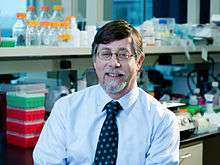Institute for Systems Biology
| non-profit | |
| Industry | Biology |
| Founded | 2000 |
| Founder | Leroy Hood, Alan Aderem, Ruedi Aebersold |
| Headquarters | Seattle, Washington, United States |
Area served | Systems Biology |
Key people |
Leroy Hood, MD, PhD, President Nitin Baliga, PhD, Senior Vice President and Director Nathan Price, PhD, Associate Director |
Number of employees | 230 |
| Website | http://www.systemsbiology.org |

Institute for Systems Biology (ISB) is a non-profit research institution located in Seattle, Washington, United States.[1] The ISB concentrates on systems biology, the study of relationships and interactions between various parts of biological systems, and advocates an interdisciplinary approach to biological research.[2]
Goals
Systems biology attempts to study biological systems in a holistic manner by integrating data at all levels of the biological information hierarchy, from global down to the individual organism, and below down to the molecular level. The vision of ISB has been to integrate these concepts using a cross-disciplinary approach combining the efforts of biologists, chemists, computer scientists, engineers, mathematicians, physicists, and physicians.[2]
On its website, ISB has defined four areas of focus:[3]
- P4 Medicine - This acronym refers to predictive, preventive, personalized and participatory medicine, which focuses on wellness rather than the mere treatment of disease.
- Global Health - Use of the systems approach towards the study of infectious diseases, vaccine development, emergence of chronic diseases, and maternal and child health.
- Sustainable Environment - Applying systems biology for a better understanding of the role of microbes in the environment and their relation to human health.
- Education & Outreach - Knowledge transfer to society through a variety of educational programs and partnerships, including the spinout of new companies.
Early history

Leroy Hood co-founded the Institute with Alan Aderem and Ruedi Aebersold in 2000.[1]
However, the story of how ISB got started actually begins in 1990.[4] Lee Hood was the director of a large molecular biotechnology lab at the California Institute of Technology in Pasadena, and was a key advisor in the Human Genome Project, having overseen development of machines that were instrumental to its later success. The University of Washington (UW), like many other universities, was eager to recruit Hood, but had neither the space nor the money to accommodate Hood's large laboratory.[4]
Lee Huntsman, director of UW's Center for Bioengineering, was attending a UW football game, sharing a luxury box with Bill Gates, the former CEO and current chairman of Microsoft. Huntsman took the opportunity to tell Gates about Hood. Bill Gates already had a considerable interest in biotechnology, both as a philanthropist and as an investor, and after meeting Hood, donated $12 million to UW to enable him to head a new department of molecular biotechnology,[4] where Hood continues to hold a faculty position as the Gates Professor of Molecular Biotechnology.[5]
ISB represents a spin-off of Hood's labs at UW.[6]
Achievements
ISB is in the top ranks of scientific institutions worldwide. In 2012, the SCImago Research Group, based in Spain, ranked ISB 4th worldwide on its Excellence Rate scale.[7]
ISB currently hosts 10 research groups with expertise ranging across genetics, microbial genetics, complex molecular machines, macromolecular complexes, gene regulatory networks, immunology, molecular and cell biology, cancer biology, genomics, proteomics, protein chemistry, computational biology and biotechnology.[1] The ISB web site lists 985 peer-reviewed publications for the years 2000 through early 2012.[8]
In late 2005, the ISB began to emphasize the application of systems biology to P4 medicine (predictive, preventive, personalized, participatory), i.e. the development of techniques for predicting and preventing disease, possibly before patients even know they are sick. The P4 Medicine institute was co-founded in 2010 by ISB and Ohio State University.[9]
The Education and Outreach efforts of ISB include creating the Logan Center for Education whose mission is to enable educators to produce STEM literate students.[10] ISB offers paid research internships for high school and undergraduate students, and offers advanced systems science courses throughout the year.
ISB has partnered in several high-profile research projects, the most significant one thus far being with the Grand Duchy of Luxembourg to create the Center for Systems Biology Luxembourg[11] and the Seattle Proteome Center.[12]
ISB faculty members have launched five companies: Cytopeia (acquired by BD in 2008), Integrated Diagnostics,[13] Macrogenics,[14] NanoString Technologies,[15] and Accelerator Corporation.[16] Accelerator Corporation, in particular, is an investment company that provides venture capital funding and management for biotech startup companies. Its portfolio companies and graduates have focused on improved biotherapeutics, vaccines, biomarkers and other such products.
See also
References
- 1 2 3 "Institute for Systems Biology - Home". Institute for Systems Biology. Retrieved 17 March 2012.
- 1 2 Hood, L.; Rowen, L.; Galas, D. J.; Aitchison, J. D. (2008). "Systems biology at the Institute for Systems Biology". Briefings in Functional Genomics and Proteomics. 7 (4): 239–248. doi:10.1093/bfgp/eln027. PMID 18579616.
- ↑ "Institute for Systems Biology - Research". Institute for Systems Biology. Retrieved 17 March 2012.
- 1 2 3 Dietrich, Bill (9 February 1992). "Future Perfect -- Thanks To Bill Gates' $12-Million Endowment, Scientist Leroy Hood Continues His Search For A New Genetic Destiny". The Seattle Times. Retrieved 17 March 2012.
- ↑ "Department of Molecular Biotechnology". University of Washington. Retrieved 17 March 2012.
- ↑ "Revolutionary New Science". Institute for Science, Engineering and Public Policy. Retrieved 17 March 2012.
- ↑ "SCImago Research Group". SCImago Research Group. Retrieved 21 March 2012.
- ↑ "Institute for Systems Biology - Publications". Institute for Systems Biology. Retrieved 17 March 2012.
- ↑ "P4 Medicine Institute". Retrieved 17 March 2012.
- ↑ "Logan Center for Education". Institute for Systems Biology. Retrieved 8 December 2015.
- ↑ Tartakoff, Joseph (5 June 2008). "Seattle, Luxembourg research projects set". Seattlepi.com (Seattle Post-Intelligencer). Retrieved 17 March 2012.
- ↑ "Seattle Proteome Center". Seattle Proteome Center. Retrieved 17 March 2012.
- ↑ "Integrated Diagnostics". Retrieved 17 March 2012.
- ↑ "Macrogenics". Retrieved 17 March 2012.
- ↑ "NanoString". Retrieved 17 March 2012.
- ↑ "Accelerator Corporation". Retrieved 17 March 2012.